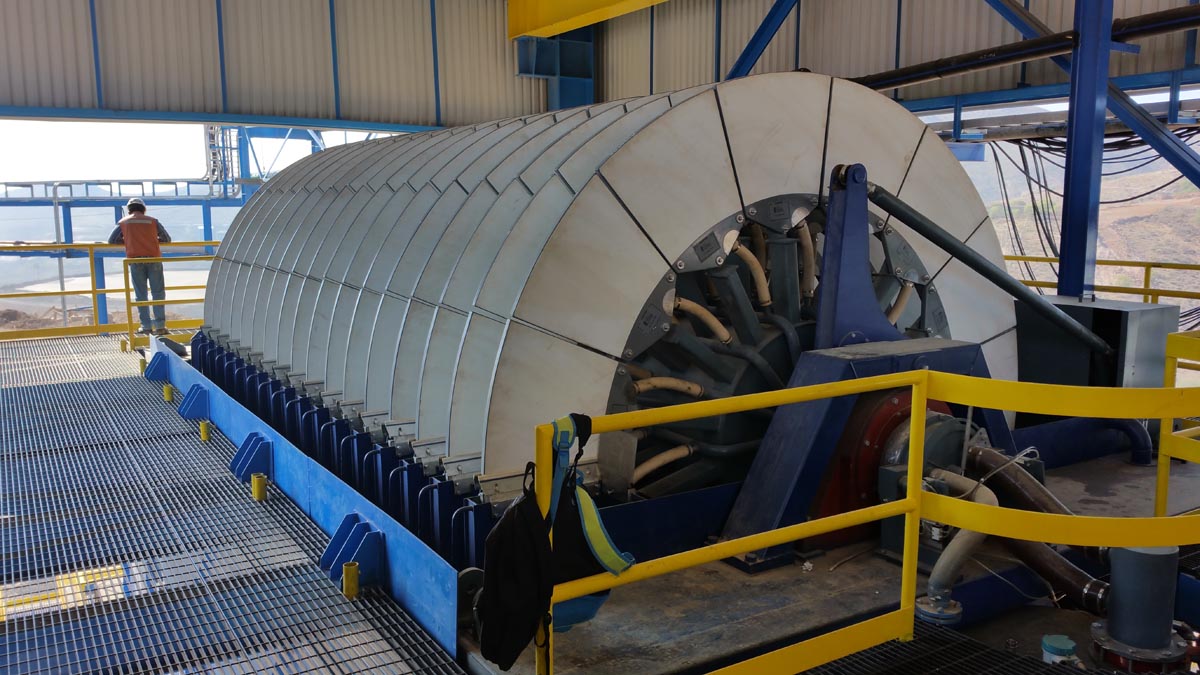Competitive Advantage
Simple yet innovative design
The filter's rotary mechanism, powered by a gear drive, rotates ceramic segments through a slurry basin. Vacuum and capillary forces draw particles to the membrane, forming a filter-cake. Filtrate from solid-liquid separation is collected for washing; excess goes to the water handling circuit.
Extended lifespan
The estimated lifespan of up to 24 months supports sustained continuous filtration campaigns in many applications. Unlike cloth disc filters prone to frequent downtime from cloth failures, CX-Series filters offer superior reliability.
Extremely low energy consumption
Ceramic membrane technology excels in energy efficiency with smaller vacuum flow rates and pump sizes per filtration area compared to cloth disc filters, resulting in up to 85% less energy consumption than conventional methods.
Solid-free filtrate reducing equipment wear
The solids-free CX-Series filtrate reduces equipment wear, returns directly to the water circuit, and sustains its backwash circuit, lowering water demand. Reintroduction without treatment cuts fines loading and clarifier workload. Lower seal water demand eliminates costly chiller systems, unlike cloth disc filters.
Maximized quality of recovered water
Using membranes ranging from 0.75 to 3.0 microns, the CX-Series filter captures fine and ultrafine particles in mineral processes, optimizing water quality. Its continuous operation simplifies process diagrams and reduces the size of downstream handling solutions to match plant throughput.
Lower cake moisture
CX-Series filters achieve 1.0-4.0% lower cake moisture than conventional vacuum filters at similar rates. Ceramic membranes allow faster filtration, producing drier cakes. This reduces filter-cake demand in paste applications, cutting costs by allowing more tailings to bypass filtration.
Reduced environmental impact
CX-Series filters yield filtrate with suspended solids levels typically between 50-200 ppm, a significant drop from conventional vacuum filters (>10,000 ppm). This minimizes product losses and reduces recirculating fines, positively affecting water and flotation chemistry.
High filtration capacity
Introducing the CX12-204 (204m2), the world's largest ceramic filter, with enhanced filtration in a compact design. Our modular approach reduces costs, enabling economies of scale for larger plants, and lowering operational and capital expenditures per tonne filtered.
Technology Highlights
Our Process
Our projects evolve, enhancing our understanding, engineering precision, and cost accuracy. We guide clients through this journey, ensuring timely achievement of investment targets. Unlike traditional OEMs, we provide a dedicated contact for comprehensive support from start to finish.
 Project Benchmarking
Project Benchmarking
Utilizing a decade's worth of data from labs and operations, coupled with observational analysis, we've created an AI model. It rapidly evaluates material "filterability" by examining their physical, chemical, and mineralogical traits. This assists in predicting costs for different filtration methods, aiding early decision-making and validating engineering feasibility.
 Bench-Scale Testwork
Bench-Scale Testwork
To optimize testwork accuracy and quality control, we've launched our subsidiary, Canadian Critical Minerals Research, conducting all bench-scale tests for clients. Our process involves collaboration between technicians and engineering staff to integrate learning outcomes into project stages. Unlike other OEMs divesting in-house labs, we're heavily investing in our 3,000 sq. ft. facility in Kamloops, BC, ensuring comprehensive services.
 Conceptual Engineering and Process Flowsheet Development
Conceptual Engineering and Process Flowsheet Development
We offer conceptual engineering services alongside initial testwork results to merge data into practical outcomes. Our process integrates sample data, mineral processing principles, and a mix of proprietary and standard equipment. These studies finalize major process elements, enabling estimation discipline.
 Pilot-Plant Testwork
Pilot-Plant Testwork
For complex projects, longer-term pilot-plant testwork may be necessary to validate data over time due to sample variability. Our facilities can handle large sample volumes and equipment for onsite pilot studies. We also provide containerized and mobile test rigs for global deployment to customer sites.
 Front-End Engineering (FEED) and Detailed Engineering
Front-End Engineering (FEED) and Detailed Engineering
Once the process flowsheet design is confirmed, we advance the project into a FEED study to improve estimate accuracy. This includes finalizing piping and instrumentation diagrams, equipment lists, and specifications for vendor engagement and procurement. With in-house engineering expertise, we also collaborate with trusted third-party consultants as needed.
 Project Execution & Construction
Project Execution & Construction
With vast experience in managing large-scale capital projects across remote areas, our team has successfully built plants in numerous countries. We handle all project execution functions, including procurement, logistics, quality assurance, and more. Our personalized project management services add significant value, with our team often acting as owner’s
 Operational Readiness (OR)
Operational Readiness (OR)
Operational Readiness is crucial for seamless handover of information from engineering to operations. Our OR phase includes thorough HAZID/HAZOP analysis and collaboration with vendors, ensuring a well-prepared workforce for day-to-day operations.
 Commissioning
Commissioning
Upon delivery, we inspect facilities for compliance and authorize equipment installation. We oversee construction verification and assist with assembly as per specs. The commissioning team supervises dry commissioning to detect issues. Wet commissioning follows, transitioning to live operations with slurry feed for filtration.
 Operations
Operations
After reaching steady-state operations, we support clients through the post-commissioning phase, known as the "valley of death." Our commissioning team remains in operational support roles for the critical first hundred days, ensuring a smooth transition with maximum impact on return of capital.
Why Choose CEC Mining Systems?
Single Point of Contact
A single point of contact to supply full scope solutions through the project life-cycle.
Testing & Design Competency
Competency in the testing, design, and applications of traditional and novel technologies.
Strong Vendor Relationships
Effective working relationships with a diverse mix of vendors and sub-contractors to assemble the best project team.
Team Integration and Support
Integration within the end-user personnel and processes to ensure unified understanding of scope and responsibilities.
Agile Responsiveness
Highly agile responsiveness to end-user requirements.
Boutique Approach
A boutique approach to project delivery.
Startup and Commissioning
Extensive start-up and commissioning capabilities and experience in remote jurisdictions.
